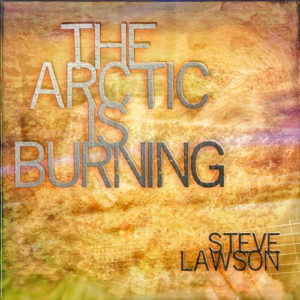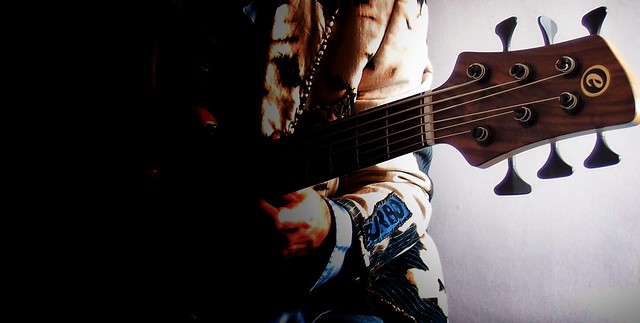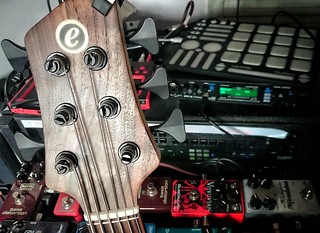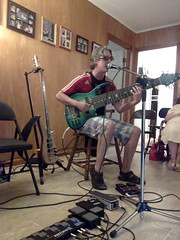[Here’s the press release for my new album, which will also serve as a blog announcement, because hey, why write two different versions of the same thing? Ergo, Steve would like to apologise for egregious use of third person, if you’re not reading this with a view to cannibalising it for your review or the news page in your magazine 😉 ]Â
The UK’s leading solo bass guitarist, Steve Lawson releases his 30th solo album, The Arctic Is Burning on Sept 2nd 2019. The album thematically picks up where 2018’s celebrated Beauty And Desolation left off, once again weaving a narrative relating to climate change around a set of improvised, unedited solo performances.
 “It’d be tough to demonstrate in a concrete way how the theme and the music are linked, if someone was being cynical about the presence of a narrative,†explains Lawson, “but improv is always about something, even if you’re just responding to the things you’ve been recently practicing and how they sit in relation to other music that you consider meaningful. For some people, those ways of relating are technical or genre-specific, but for me the desire is – at least until the technical side falls apart – emotional. I want to make music that makes me feel the way the artists who move me make me feel.†He continues, “I want the brokenness of The Blue Nile or Talk Talk, the sense of place of Bill Frisell, the honesty of Joni Mitchell, the anger of Bruce Cockburn, the wilful naivety of The Minutemen, the pristine poetry of Jonatha Brooke, whose music is such a natural and flowing extension of whatever she’s singing about…â€
“It’d be tough to demonstrate in a concrete way how the theme and the music are linked, if someone was being cynical about the presence of a narrative,†explains Lawson, “but improv is always about something, even if you’re just responding to the things you’ve been recently practicing and how they sit in relation to other music that you consider meaningful. For some people, those ways of relating are technical or genre-specific, but for me the desire is – at least until the technical side falls apart – emotional. I want to make music that makes me feel the way the artists who move me make me feel.†He continues, “I want the brokenness of The Blue Nile or Talk Talk, the sense of place of Bill Frisell, the honesty of Joni Mitchell, the anger of Bruce Cockburn, the wilful naivety of The Minutemen, the pristine poetry of Jonatha Brooke, whose music is such a natural and flowing extension of whatever she’s singing about…â€
Indeed, across the four tracks on The Arctic Is Burning, Lawson’s melodic turn is towards a slightly more straightforward rock-based language, in contrast to the some of the obtuse harmonic complexity of Beauty And Desolation. The album is not without it’s moments of dissonance and angularity but they tend to be crescendos to otherwise more pop-oriented melodic adventures, rather than the backbone of the entire track. “I’m not entirely sure how that happened – the subscriber-only album I released in the run-up to making Arctic… has plenty of the more angular freaky melodic stuff on it, as well as some very prominent field recordings that are entirely absent from this album. One of the joys of being ‘pan-idiomatic’ is that I have a dialectical relationship between the continuity of my own voice and the disparate range of genre signifiers I can drop in and out of.â€
The role of the Bandcamp subscription is never far from Steve’s explanation of his music, frequently inspiring extended Twitter and Facebook commentary relating to the ongoing sustainability of making niche music.
“It’s SO obvious to me,†he says, “we just don’t have a streaming model that offers anything like sustainable economics to niche artists. It’s a world that doesn’t reward artists who form communities, just those who chase ubiquity. It’s great for people whose music-making aspirations are towards producing fodder for playlists or chasing pop stardom, but if your music practice has no path to a couple of hundred thousand listeners a month, forget being able to feed yourself with it. The Bandcamp subscription is absolutely the economic and social lifeblood of my music making world. The subscribers provide not only the financial resources to make the music, but an orientation – a direction in which to project musical ideas. The myths around creative freedom can end up with artists spouting all kinds of nonsense about just chasing our muse, but ultimately there’s a direction to what we do, whether that’s our peers, radio, our existing audience or the malcontents who post abusive comments on YouTube. For me, it’s been vital to cultivate a space where people who are materially and psychologically invested in what I’m up to get to encounter more of it than I could ever release to the wider public, and where we get to talk about it and go back and forth over its meaning without it clogging up more generic social media forums. The subscriber community is growing steadily and provides a level of continuity to my practice of documenting all the music I make. I get to release upwards of 8-10 albums a year because of them, plus extra video!â€
Indeed, being that prolific, it can be a challenge to decide what to release to ‘muggles’ and what to keep just for subscribers, especially with some of Lawson’s own personal favourites still squirrelled away in the subscriber allocation – “My album from 2017 with Bryan Corbett is easily in my top 2 or 3 favourite musical things I’ve ever done, and I’m still waiting for the right time to put it out. I should just get on with it, cos it’s not like it’s suddenly going to be a hit whenever it happens, but I do like to leave a few months between each public release!â€
2019 marks the 20th Anniversary of Lawson’s first ‘proper’ solo gig (“I’d played solo tunes in other settings before,†he explains, “but never a whole show to people who’d paid just to see me!â€) – so 20 years on and 30 albums in, we get to experience all over again why he’s been one of the most talked about British bass experimenters for those two decades. The musician Bass Guitar Magazine described as ‘Britain’s most innovative bassist, no contest’ is still pushing boundaries, and exploring just how far the scope of live solo performance with nothing pre-recorded can be pushed. The Arctic Is Burning reaches new heights while still being instantly recognisable as a Steve Lawson record. Here’s to the next 20 years!
The Arctic Is Burning will be out on Sept 2nd 2019,
exclusively via Bandcamp at music.stevelawson.net
For interviews contact Steve directly.
For press photos click here.




 Here are the latest couple of videos I’ve put up. The first is another of the experimental ideas I’m working on for the new album – this time I wanted to try something a little more solidly rhythmic, just to see how the replace functions interact with a percussive track. (the part is played by muting all the strings, and then using a ‘double thumb’ technique, more readily associated with slap bass, to get the percussive pattern).
Here are the latest couple of videos I’ve put up. The first is another of the experimental ideas I’m working on for the new album – this time I wanted to try something a little more solidly rhythmic, just to see how the replace functions interact with a percussive track. (the part is played by muting all the strings, and then using a ‘double thumb’ technique, more readily associated with slap bass, to get the percussive pattern).